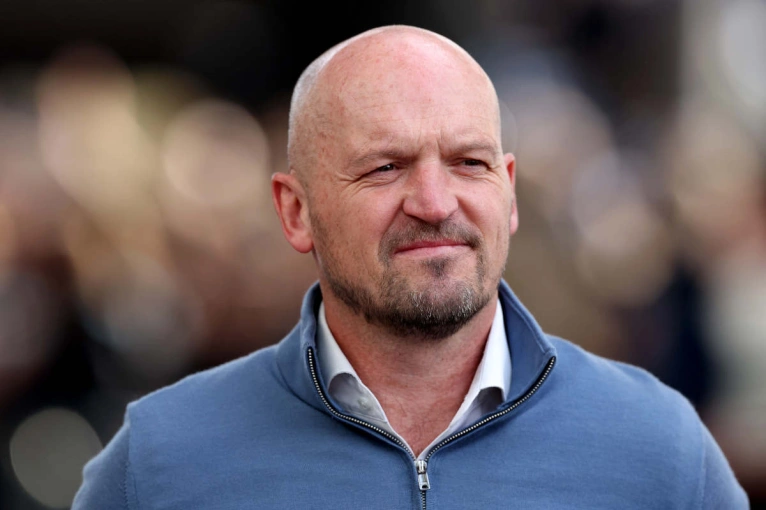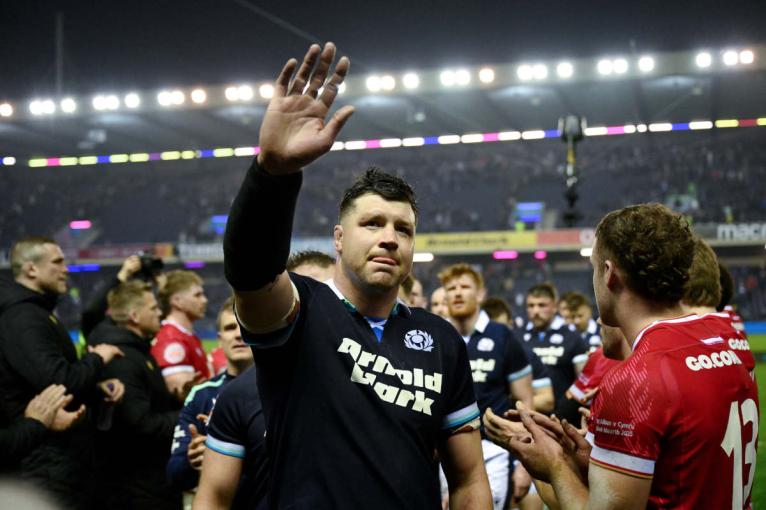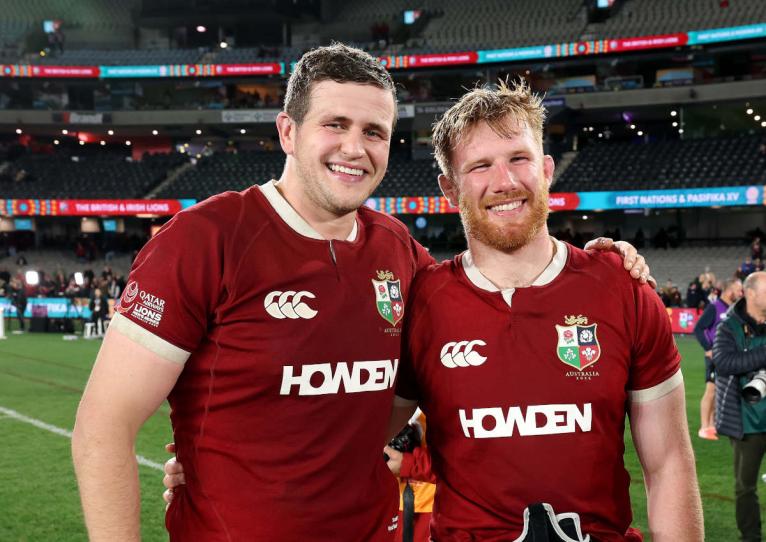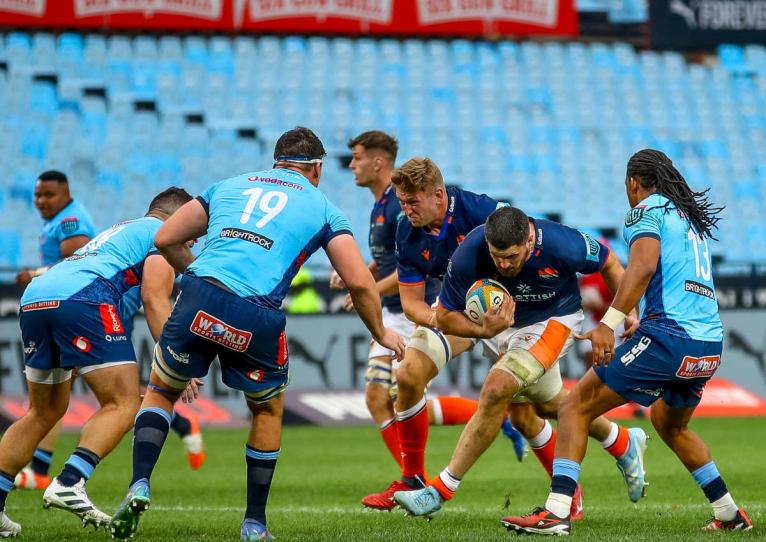If Gregor Townsend is having any sleepless nights pondering some tricky selection dilemmas for the forthcoming Autumn Nations Series, one assumes he has a plentiful supply of a popular energy drink on tap these days to keep the grey matter whirring.
The Scotland head coach’s side hustle as a part-time consultant for Red Bull on rugby strategy has generated plenty of heat and noise over its timing – Townsend having recently signed a new deal to take the national side through to the 2027 World Cup – and talk of potential conflicts of interest down the line, with Newcastle the only rugby club in the Austrian company’s portfolio.
But if his phone has been running hot in recent days and weeks with the machinations leading to Steve Diamond’s departure and an overhaul of management staff at the English Prem club, the day job is demanding full-time attention again.
With the recruitment of Steve Tandy’s replacement as defence coach complete in the shape of Lee Radford, there is a playing squad to be finalised over the next fortnight ahead of Murrayfield visits by the USA, New Zealand, Argentina and Tonga next month.
 Townsend, under the microscope over his advisory role with Red Bull, is preparing for his ninth season as Scotland head coach (Photo Ian MacNicol/Getty Images)
Townsend, under the microscope over his advisory role with Red Bull, is preparing for his ninth season as Scotland head coach (Photo Ian MacNicol/Getty Images)
Although there are lingering concerns over the readiness of key forwards Zander Fagerson, Rory Darge and Jack Dempsey, and British & Irish Lions centre Huw Jones will be missing following post-tour surgery, in some areas Townsend will be scratching his head over who to leave out.
Nowhere more so than in the second row, where he is spoilt for choice with a dozen or more contenders vying for maybe six slots in a likely 40-plus strong group, ranging from gnarled veterans and established Test players to those in their mid-20s itching for more career development and young thrusters whose raw talent could be fast-tracked into the Test arena.
Scotland have played 20 Tests, and 21 games in all including the non-cap match against the New Zealand Maori this summer, since their wretched pool-stage exit from the 2023 World Cup.
In that period they have used 13 different locks, with only the much-travelled Richie Gray, now 36, no longer in the selection mix having effectively put an end to his own Test career by taking up a contract with Japanese club Toyota Verblitz 12 months ago.
Jonny Gray did return to the Scotland fold for the Six Nations… but the comeback lacked some of the authority of old and it seems far from guaranteed that he will add to his 81 Tests
Gray’s second coming as a high-class Test performer unfortunately ended with a bicep injury in the first game of the 2024 Six Nations against Wales, on the occasion of his 79th cap.
But there are still two more second-row stalwarts Townsend could call upon, should he choose to, even if there must be doubts whether either will last the course until the 2027 World Cup. At this halfway point in the four-year cycle, Townsend may need to make a call on that sooner rather than later if he feels others need more time in the saddle in the lead-up to Australia.
Gray’s younger brother Jonny may only be 31 but has plenty of miles on the battered body clock. He has done superbly well to resurrect a top-level career that was threatened by a serious knee injury which wiped out his entire final season at Exeter and saw him miss the 2023 RWC.
After moving to France with Bordeaux, Gray turned down an initial call-up from Townsend for last autumn’s Tests, preferring to focus on managing his playing load at his new club after such an extended period out.
 Gray has been a Scotland stalwart since 2013 but it remains to be seen if he will continue his Test career through to RWC27 (Photo David Rogers/Getty Images)
Gray has been a Scotland stalwart since 2013 but it remains to be seen if he will continue his Test career through to RWC27 (Photo David Rogers/Getty Images)
He did return to the Scotland fold for the Six Nations, starting the first four games before being forced to withdraw from the bench for the final fixture in Paris. But the comeback lacked some of the authority of old and it seems far from guaranteed that Gray, who may return to the UK from Bordeaux at the end of the season, will add to his 81 Tests, even if Townsend values his contribution and character.
The same could be said for the reliable Grant Gilchrist, who has started more Tests (14) than any other lock since the last RWC and now sits joint-eighth on Scotland’s all-time list of cap holders on 82, level with Townsend, and five behind the nation’s most-capped lock, Scott Murray.
The head coach never misses an opportunity to praise the Edinburgh veteran’s leadership and still felt the need to take the 35-year-old on this summer’s Pacific tour (after giving him the previous summer off), with Gray left at home to recover from an arduous campaign which culminated in the French Top 14 final, and Scott Cummings away with the Lions.
Cummings, who some observers felt was unlucky not to make the Lions Test 23 after some impressive displays following a shaky first start against Western Force, is probably the closest to being a sure-fire pick.
Gilchrist and Cummings might still be the pairing Townsend reverts to for the biggest Tests next month, although advancing the already rapid development of other options may be a more pressing medium-term priority
The Glasgow bulwark has won 42 caps and is in his prime approaching his 29th birthday, his surprisingly deft angles of running and handling providing a point of difference to accompany his outstanding work-rate and set-piece efficiency.
After Richie Gray’s injury-hastened exit, Cummings and Gilchrist were Townsend’s go-to partnership for the 2024 Six Nations and last year’s autumn Tests before Cummings’ broken arm just before this year’s Six Nations created a vacancy which Jonny Gray filled.
Ordinarily it may have been an opportunity for the abrasive Sam Skinner to get a rare run of starts – he has never started more than two in a row for Scotland – with 19 of his 37 caps coming off the bench. But the 30-year-old Edinburgh lock endured a frustrating season after a lengthy recovery from summer knee surgery. Although he featured a couple of times off the bench in the Six Nations and could still fill the ‘steady hand if required’ role, Skinner has not started a Test since the last RWC and was left at home this summer, with younger rivals given their head.
Gilchrist and Cummings might still be the pairing Townsend reverts to for the biggest Tests next month against the All Blacks and Pumas, although advancing the already rapid development of other options may be a more pressing medium-term priority, with perhaps only 21 more Tests plus three or four warm-up games before the next global jamboree.
 Gilchrist, 35, could become Scotland’s most capped lock if he remains part of Townsend’s plans (Photo Stu Forster/Getty Images)
Gilchrist, 35, could become Scotland’s most capped lock if he remains part of Townsend’s plans (Photo Stu Forster/Getty Images)
After the last one, Gilchrist gave little indication that he wouldn’t be targeting a fourth RWC, when he will be 37. “I’ve said I’m not going to step away,” he said. “I’ve not been good enough at times in my career to play for Scotland. It’s about being on form and good enough to play. If I’m good enough to play, I want to play because I love playing for Scotland.”
So which movers and shakers might unseat the more experienced names and establish their own claims on the number four and five shirts heading into that RWC?
Glasgow duo Gregor Brown (24) and Max Williamson (23), plus Edinburgh’s Marshall Sykes (25), are perhaps at the head of the queue among those ready to kick on, with Leicester first-choice Cam Henderson (25), Ewan Johnson (26), the France-based Scot now with Top 14 leaders Bayonne, and two more Warriors in Alex Samuel (22) and the uncapped Jare Oguntibeju (23) also pushing hard.
Brown, the cousin of Scotland full-back Blair Kinghorn and one of Glasgow head coach Franco Smith’s treasured ‘flocks’ – a hybrid lock or blindside flanker – is the only one of that group into double figures, having won 10 caps since his debut on the 2024 tour of the Americas.
Williamson made a strong impression in what Townsend called a “brilliant” 50-minute outing against the Springboks last November, going toe-to-toe with Eben Etzebeth and RG Snyman
Brown joined Gilchrist in the boiler room for the final Six Nations game against France, and again for their most recent Test against Samoa in July. If his proximity to Australia may have been a factor in his call-up for the Lions’ final midweek game four days later, it also signalled the direction his career is heading and he looks ripe for further advancement this autumn.
The strapping Williamson may have had further opportunities already but for injury misfortune. In outstanding form for Glasgow this time last year, he made a strong impression in what Townsend called a “brilliant” 50-minute outing against the Springboks last November, going toe-to-toe with Eben Etzebeth and RG Snyman, only to suffer a thumb injury which required surgery.
Williamson was poised to return on the eve of the Six Nations only to re-injure the same thumb and miss the entire championship. He did feature twice in the summer off the bench, where he has also begun the season with Glasgow, and may have to bide his time. But given his imposing physique, you sense Townsend would love to see more of him in the Test arena.
Alex Craig (28), the former Scarlet who made the 23 for Scotland’s final autumn Test against Australia last year, may come into the reckoning once he gets going at Glasgow, but competition at Scotstoun is so intense at lock that no-one is guaranteed a regular run, with five Scotland internationals – Cummings, Brown, Williamson, Samuel and Craig – jostling for places and the raw talent of the 123kg (19st 5lb), 6ft 8in Oguntibeju threatening to upstage them all.
 Could Scott Cummings and Gregor Brown, who played together for the Lions against First Nations & Pasifika, recreate their partnership with Scotland? (Photo David Rogers/Getty Images)
Could Scott Cummings and Gregor Brown, who played together for the Lions against First Nations & Pasifika, recreate their partnership with Scotland? (Photo David Rogers/Getty Images)
“It was already five and then Jare has played really well in pre-season and the start of the campaign, so yes, it’s very competitive but still pretty friendly, I’d say,” underlined the 6ft 9in Samuel. “There’s a bit of dig and niggle in training, but I think it’s good for the team generally.”
Samuel made his Scotland debut last autumn against Portugal but then missed out on the Six Nations and was “really disappointed” not to tour this summer, having featured in 25 of Glasgow’s 26 games last season, including 14 starts.
“I had a look back at what more I could have done to get involved and I’ve been developing my ball carry, the attacking side of my game and a couple of things around set-piece,” he said. “I think I’ve got a good opportunity now to try and push to make the autumn squad.”
Sykes is another reaping the benefits of an extended run of games at club level, having started 18 of his 20 outings with Edinburgh last season. First capped as a 21-year-old against Tonga in November 2021, one of eight debutants that day, he had to wait another four years for his second cap, as a replacement against France in March.
I definitely feel a more rounded player now who can thrive in the environment compared to then, when I was just trying to survive and live up to the standard.
“Yeah, it took a little while!” he reflected this week. “That has been a massive goal. [Scotland forwards coach] JD [John Dalziel] spoke to me when I made that Six Nations squad and he was really happy because it was the first time in about six phone calls he was able to give me good news. A lot of it had been ‘you’re close but you need to do this’, or ‘you need to do that’.
“To get that news after a half-decent start to last season just spurred me on and getting that game at the end was huge. I know we didn’t come out with the result, but for me, having not touched a Scotland shirt for four years, it was pretty significant to get back into it.”
Two more caps followed this summer against Fiji and Samoa, 12 months on from making some conscious choices to improve his diet – “it’s not about extreme changes but the little things you can do around creating every-day habits you can keep up” – work on his strength and conditioning and give himself the best chance to fulfil his potential.
“I was always good at the foundational stuff around breakdown and set-piece, so I didn’t feel out of place,” Sykes said of his 2021 debut. “But I definitely feel a more rounded player now who can thrive in the environment compared to then, when I was just trying to survive and live up to the standard. Now I can add to that and it’s something I want to continue to do. It’s great competition and something which motivates me hugely.”
 Sykes (with ball) has become a consistent starter for Edinburgh since the beginning of last season (Photo Gordon Arons/Gallo Images/Getty Images)
Sykes (with ball) has become a consistent starter for Edinburgh since the beginning of last season (Photo Gordon Arons/Gallo Images/Getty Images)
Sykes’ rivals at club level, alongside Skinner and Gilchrist, include three other locks with eyes on the Scotland prize. The athletic Glen Young (30) won his fourth cap against Canada last summer before being forced home by injury and struggling for game-time last season.
There is also the uncapped Callum Hunter-Hill (28), who has had his own injury hassles but is poised for a second debut for the club after five years with Saracens and one at Northampton, while the 6ft 11in giant Rob Carmichael (22), believed to be the tallest player in professional rugby anywhere – has an obvious USP if he can get some regular outings for the capital side.
He’s at the right age now, when front-five players come through. The world is his oyster…it’s in his hands.
But Edinburgh head coach Sean Everitt believes Sykes can become a Scotland regular if he maintains his recent consistency of performance.
“I think it was a bit of self-discipline and drive,” Everitt said. “When I came in, we had a chat with all our second-rows, who were talking about being behind Sam Skinner and Grant Gilchrist. It’s easy to ask for selection but you’ve also got to earn it and the right to be in a rotation group.
“He made the right choice. He decided he needed to improve and he worked incredibly hard at his game. He got rewarded for that and once you get rewarded for hard work, it keeps up the motivation. He has been one of our better second-rows over the last season. He got the minutes and the rewards by being selected for Scotland too. It’s exciting times. He’s at the right age now, (going on) 26, when front-five players come through. The world is his oyster…it’s in his hands.”
And Townsend’s too, perhaps. But then Sykes is far from alone in putting forward a strong case. Twelve into six, and then down to two. Decisions, decisions. Over to you, Gregor.

